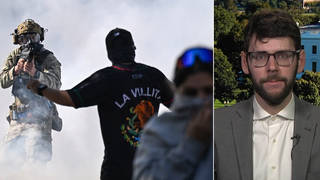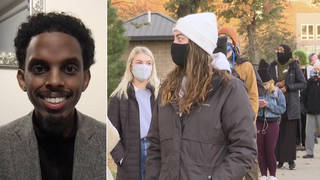
Topics
Guests
- Barbara BarrettWashington correspondent with McClatchy Newspapers. Her articles include 'Toxins in Camp Lejeune Water 30 Years Ago Still a Problem' and 'Marine Base's Ex-residents, Many Ill, Only Now Learning of Toxic Water’
- Jerome Ensmingerformer Marine. His daughter Janey was conceived when he was at Camp Lejeune. She died of leukemia in 1985. He has testified three times before Congress and is the co-founder of the site: 'The Few The Proud The Forgotten'
We turn now to a story of environmental contamination that has been brewing for decades. Last week, the US Navy finally agreed to pay over $1.5 million to fund a study looking into the health effects of water contamination at the Camp Lejeune Marine Corps Base in North Carolina. The study could show a link between toxic water at the base and the illnesses and deaths of Marines and their family members over a thirty-year period from the late 1950s to the late 1980s. Thousands of Marines and their families who were stationed at Camp Lejeune have long complained of illnesses and deaths linked to exposure to toxic water. Health officials estimate that one million people were exposed to contaminated well water at the base before the main well was shut down in 1984. [includes rush transcript]
Transcript
AMY GOODMAN: We turn now to a story of environmental contamination that’s been brewing for decades. Last week, the Navy finally agreed to pay over $1.5 million to fund a study looking into the health effects of water contamination at Camp Lejeune, the Marine Corps base in North Carolina. The study could show a link between toxic water at the base and the illnesses and deaths of Marines and their family members for a thirty-year period from the late ’50s to the late ’80s.
Thousands of Marines and their families who were stationed at Camp Lejeune have long complained of illnesses and deaths linked to exposure to toxic water. Health officials estimate a million people were exposed to contaminated well water at the base before the main well was shut down in 1984. But the Navy had refused to fund such a study for months, despite bipartisan demands from North Carolina politicians.
Documents recently reviewed by the press revealed the contamination was far more extensive and deadly than previously assumed. They point to massive leaks of benzene, a known carcinogen, from a fuel storage farm at Camp Lejeune. They also suggest an environmental contractor dramatically underreported the level of benzene found in tap water in 1984, then omitted it altogether as the Marine base prepared for a federal health review a decade later.
For more on the story, I’m joined in Washington, DC by Barbara Barrett, the Washington correspondent with McClatchy Newspapers who’s closely following this story. And joining us on the line from White Lake, North Carolina is a former Marine, Jerome Ensminger. His daughter Janey was conceived when he was at Camp Lejeune. She died of leukemia in 1985. He’s testified three times before Congress and is the co-founder of the site “The Few, The Proud, The Forgotten.”
We welcome you both to Democracy Now! Barbara Barrett, lay out the story.
BARBARA BARRETT: Well, essentially, as you mentioned, this has been going on for those former Marines and their families who lived on base from 1957 through 1987. There are some estimates that as many as a million people might have been exposed over that time. The contaminants include TCE, PCE, benzene and vinyl chloride. For a long time the Marines blamed this, in part, on a dry cleaner near the base and said that the main contaminants were TCE, trichoroethylene, and PCE, tetrachloroethylene.
But McClatchy reported over a week ago that these new documents show that as many as 800,000 gallons of benzene, which is a component of fuel, might have been spilled at this centrally located fuel farm on base over the course of — you know, we’re not entirely sure. There may be some estimates that it could be even more. We’re trying to learn more, as are folks like Jerry Ensminger. But right now, this changes a lot of the science of what’s going on.
As you mentioned, the Navy agreed last week to finally fund this mortality study. It’s about $1.5 million. It will compare the deaths of Marines based at Camp Lejeune to the deaths of Marines based at Camp Pendleton to see if they can track some sort of more definitive link between the contamination from Lejeune with the rest of — with those Marines who were not exposed at Camp Pendleton.
AMY GOODMAN: Where did this study come from? I mean, what kind of pressure has been applied on the Navy to agree to this study, after how many decades?
BARBARA BARRETT: Well, Camp Lejeune is listed as a Superfund site under the EPA because of the contamination, and they have been working on this cleanup. So that’s been going on. Meanwhile, the Marines have been told to contact former Marines and their families who have lived there over the years. They have done some efforts with that. They’ve worked with the IRS to contact people. They’ve also put advertisements in magazines and newspapers trying to reach out to people.
But really, the ATSDR, the Agency for Toxic Substances and Disease Registry, an arm of the CDC, has been responsible for years and trying to understand more definitively a scientific link between the contamination and a variety of cancers that family members have been reporting, along with other illnesses. There’s a whole host of studies that ATSDR has been trying to do. One of the key studies is this mortality study, because scientists really believe it will help develop a more definitive link between the contamination and actual deaths that could be linked to that.
There are, as you mentioned, lawmakers from North Carolina — excuse me, Senator Richard Burr, a Republican, and Senator Kay Hagan, a Democrat — who have been pushing hard for this, for this study to happen. The newly revealed documents last week inspired Representative Brad Miller in the House. He’s a Democrat from North Carolina and is the chairman of the Oversight Panel on the House Science Committee. He’s called for an investigation into these documents and why they haven’t been revealed earlier.
As a matter of fact, the first that ATSDR really knew about the benzene came just over a year ago. They had put out a study a decade ago about the TCE and PCE contaminants and its possible link. A little over a year ago, they learned, through the activism of some family members, about the benzene link. They actually retracted that earlier study and have — are trying now to learn more about the benzene and its impact. Benzene is a known carcinogen.
AMY GOODMAN: Jerome Ensminger, can you tell us the story of your family? You were a former Marine stationed at Camp Lejeune.
JEROME ENSMINGER: Yes. Good morning, by the way.
AMY GOODMAN: It’s good to have you with us.
JEROME ENSMINGER: My daughter Janey, as Barbara had mentioned before or earlier, that she was the only one of my four children that was conceived while we lived at Camp Lejeune. Subsequently, Janey was diagnosed when she was six years old with acute lymphocytic leukemia. We watched her die a little bit at a time for nearly two-and-a-half years, until that fateful day in September of 1985 when she finally passed away.
Well, from the date of her diagnosis until a day in August of 1997, I always had this nagging question about why did this happen. Why did this happen to my daughter? Why did she have to go through this hell? And I never thought that I was ever going to get an answer to that nagging question. And one evening in August of 1997, I was walking in the living room from the kitchen with a plate of spaghetti to sit down and watch the evening news, and as I walked into the living room, the reporter on the television stated that ATSDR had completed their public health assessment for Camp Lejeune, and the chemicals that had been found in the drinking water — and they incorrectly stated from 1968 through 1985 — were linked to childhood cancer, primarily leukemia. Well, I’m here to tell you, I dropped my plate of spaghetti on the living room floor. And, you know, I got a glimmer of hope at that time that I may get an answer to that nagging question. And ever since that time, I have been active in getting all the rest of these people an answer to that nagging question that they may have.
So — and I’d like to point out one thing, that the 1957 date through 1987 is for the Tarawa Terrace housing area only. That was determined through ATSDR’s water modeling effort there. ATSDR is currently modeling the water systems at Hadnot Point, which is commonly referred to as Mainside, where most of the Marines that were stationed at Camp Lejeune would have been, and also their Holcomb Boulevard water system, which back in the ’80s, early to mid-’80s, there were eight different drinking water systems aboard the base.
AMY GOODMAN: Through this time, what was known? And also, the VA system that treats vets, what happens to the families of vets?
JEROME ENSMINGER: Well, I mean, that’s, you know, the way that Senator Burr had written his version of the bill, which is S. 1518, which eventually got basically overturned or overruled by the Veterans Affairs Committee back in January in a mark-up vote. Their proposal is that they create a panel of experts and that these panel of experts would determine whether or not these folks’ exposures were related to the chemicals that they were exposed to in the drinking water at Camp Lejeune, and then these people would be afforded TRICARE through the military system. But they would automatically be provided TRICARE for five years. But then this panel was supposed to come out and review all these people’s — case-by-case basis and determine whether or not they were harmed, and if they determined they were harmed, then they would get — they would remain on that TRICARE, I guess, for the rest of their lives.
I can tell you now that any proposal such as that, when you bring in the military back into the picture, that decision is going to have to be made by the Senate Armed Services Committee, not the Veterans Affairs Committee. And I will guarantee you — I mean, the military has been denying this for years. And I’ll guarantee you that the Senate Armed Services Committee is not going to act upon this proposal by the Veterans Affairs committee. The VA, who was supportive — I mean, not supportive, but these veterans service organizations, such as the American Legion, the Disabled American Veterans — you know, most of these organizations were backing Senator Burr’s bill up until three days prior to the mark-up hearing in January. And then, all of a sudden, and mysteriously, these folks all come out with a letter against this proposal for these veterans’ family members to be provided healthcare through the VA? I find that awful odd. And, you know, it really looks like somebody solicited those negative letters.
AMY GOODMAN: You’re a former master sergeant, Jerry Ensminger. How does this make you feel about the military?
JEROME ENSMINGER: Well, if you looked at our website and the title of it, “The Few, The Proud, The Forgotten,” it was a take off of the Marine slogan, “The Few, The Proud, The Marines.” I realize that, you know, our motto, Semper fidelis, still means an awful lot to the people down in the rank-and-file in the operating units, but I’m sad to say that when you start dealing with the hierarchy of the Marine Corps and the senior leadership and the civilian leadership of the military services, Semper fidelis, which means “always faithful” in Latin, only means something when it benefits them. It’s a sad commentary, but once the Department of Defense is finished with you, it’s just like you’re like a plastic bottle of water, drinking water. As long as that bottle has some water in it, it’s a useful asset. Once you’re done with it, that plastic bottle becomes a liability. And that’s what veterans are to the Department of Defense. They love to go out there and wrap themselves in the flag, and so do a lot of politicians. And they are always talking about “We need to support our military men and their families and our veterans,” but that’s all showmanship. Behind the scenes, they’re saying, “Hey, you know, go away.”
AMY GOODMAN: Well, clearly, you’re not, Jerome Ensminger, former master sergeant, a Marine. I want to thank you very much for being with us. We certainly will continue to follow this story, former Marine stationed at Camp Lejeune. His daughter Janey died of leukemia in 1985. I also want to thank Barbara Barrett, the Washington, DC reporter for McClatchy News, for exposing this story.












Media Options